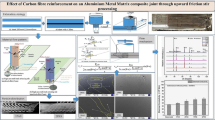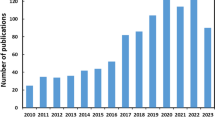Abstract
In surface modification applications, cermets such as Cr3C2–NiCr are used to enhance the wear resistance of the substrate. Friction surfaced cladding is a recently developed solid-state surface modification process in which the deposition of the clad layer is accomplished below it’s melting temperature, so that degradation of the substrate is minimized. The present investigation discusses the friction surfaced cladding of Cr3C2–NiCr using consumable die steel rod. It was observed from the micrographs, that with the suitable combination of tool plunging rate (plunging speed), tool rotational speed and traverse rate, successful cladding of Cr3C2–NiCr was achieved. A plan of full factorial experiment was followed for determining the process variables for the successful deposition of Cr3C2–NiCr clad layer with the substrate. A mathematical model was developed to predict the composite clad dimensions and microhardness with respect to the process variables. Depending upon the process parameter, it was observed that the hardness of the clad and clad geometrical feature varied. The microstructural analysis exhibited sound and uniform bonding of clad layer to the substrate and near uniform distribution of Cr3C2–NiCr. Desirability based multi-response optimization procedure was followed to arrive at optimized Cr3C2–NiCr clad.











Similar content being viewed by others
References
Gandra J, Miranda R M, and Vilaça P, J Mater Process Technol 212 (2012) 1676.
Vilaça P, Gandra J, and Vidal C, in Aluminium Alloys - New Trends in Fabrication and Applications (2012) p 159.
Bedford G M, Metals Mater 6 (1990) 702.
Macedo M L K, Pinheiro G A, dos Santos J F, and Strohaecker T R, Welding Int 6 (2014) 422.
Gandra J, Vigarinho P, Pereira D, Miranda R M, Velhinho A, and Vilaça P, Mater Des 52 (2013) 373.
Pereiraa D, Gandra J, Pamies-Teixeiraa J, Miranda R M, and Vilaça P, J Mater Process Technol 214 (2014) 2858.
Gandra J, Pereiraa D, Miranda R M, Silva R J C, and Vilaça P, Surf Coat Technol 223 (2013) 32.
Lin Y C, and Wang S W, Tribol Int 36 (2003) 1.
Zhang S, Zohu J, Guo B, Zhou H, and Pu Y, Mater Sci Eng A 491 (2008) 47.
Gandra J, Pereira D, Miranda R M, and Vilaçaca P, Procedia CIRP 7 (2013) 341.
Puli R, and Janaki Ram G D, Mater Charact 74 (2012) 49.
Puli R, and Janaki Ram G D, Surf Coat Technol 207 (2012) 310.
Puli R, and Janaki Ram G D, Corros Sci 62 (2012) 95.
Puli R, and Janaki Ram G D, Surf Coat Technol 209 (2012) 1.
Rafi H K, Janaki Ram G D, Phanikumar G, and Rao K P, Mater Des 32 (2011) 82.
Rao K P, Damodaram R, Rafi H K, Janaki Ram G D, Reddy G M, and Nagalakshmi R, Mater Charact 70 (2012) 111.
Rao K P, Sankar A, Rafi H K, Janaki Ram G D, and Reddy G M, Int J Adv Manuf Technol 65 (2013) 755.
Dilip J J S, Rafi H K, and Janaki Ram G D, Trans Indian I Met 64 (2011) 27.
Puli R, Kumar E N, and Janaki Ram G D, Trans Indian I Met 64 (2011) 41.
Chandrasekaran M, Batchelor A W, and Jana S, J Mater Sci 33 (1998) 2709.
Tokisue H, Katoh K, Asahina T, and Ushiyama T, in Structures and Mechanical Properties of Multilayer Friction Surfaced Aluminum Alloys, Report of the Research Institute of Industrial Technology, Nihon University Number 78 (2005).
Sakihama H, Tokisue H, and Katoh K, Mater Trans 44 (2003) 2688.
Kramer de Macedo M L, Pinheiro G A, dos Santos J F, and Strohaecker T R, Weld Int 24 (2010) 422.
Vitanov V I, Javaid N, and Stephenson D J, Surf Coat Technol 204 (2010) 3501.
Gandra J, Krohn H, Miranda R M, Vilaca P, Quintino L, and dos San J F, J Mater Process Technol 214 (2014) 1062.
Rafi H K, Janaki Ram G D, Phanikumar G, and Rao K P, Mater Sci Forum 638–642 (2010) 864.
Voutchkov I, Jaworski B, Vitanov V I, and Bedford G M, Surf Coat Technol 141 (2001) 26.
Author information
Authors and Affiliations
Corresponding author
Rights and permissions
About this article
Cite this article
Yadav, R., Pandey, C., Mahapatra, M.M. et al. Study on Effect of Process Variables on Distributed Compositional Characteristics in Metallurgically and Mechanically Bonded Claddings. Trans Indian Inst Met 70, 1805–1815 (2017). https://doi.org/10.1007/s12666-016-0977-6
Received:
Accepted:
Published:
Issue Date:
DOI: https://doi.org/10.1007/s12666-016-0977-6




